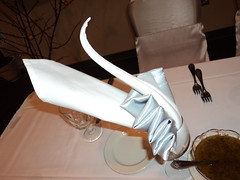 Image by dj venus via Flickr
Image by dj venus via FlickrThe Great Shrink
Why have dinner napkins gotten so darn small?Others, at dinner, might worry about locality, seasonality or who the pig's grandparents were.
I worry about the size of the napkins. Large snowy fields of linen that drape my lap and protect me, with a graciousness you can measure: That's what I'm looking for. (more after the break)
To be presented with a super-scaled napkin is to tell me that my host, whether publicly or privately, has eaten well, traveled extensively, knows what they're doing and cares about me. It's like they've given me the shirt off their back.
My first fine-dining experiences involved large napkins, a kind of capaciousness matched by great globes of glass for the wines and large plates or bowls for the food, whether a basic pasta in an Italian beach town or some architectural triumph in a two-star establishment outside of Paris, working on its third star. There was even ritual: The waiter would toss the napkin out in a billow and let it float to your lap. Welcome.
So, when I set up house, and went out to buy dinner napkins, I assumed the big ones were out there.
I have ugly news for you. The dinner napkin today is a fraction of its former self. And it matters less and less where you eat or shop. What seemed reasonably gigantic to me is becoming a thing of the past.
The 30-inch square, which was considered suitable as lately as 25 years ago, is now likely to be 20 to 22 inches square in a restaurant, and 18 to 22 inches at home. In a reverse trend, lunch napkins, which used to stay a respectful step behind, at 14 to 20 inches, are getting larger—even on the best laps—so that you don't have to own more than one set of napkins to get through the day.
"We used to stock 27 inches," said Patty Forrest, manager of the E. Braun store in New York, which sells fine linens. "It's moving down to 24; 20 was always the luncheon. Twenty-two has become the norm for lunch and dinner." E. Braun continues to sell 27-inch napkins to clients who are "a bit more old-fashioned," Ms. Forrest said, "people with a more formal view of dining." E. Braun, as well as Léron, another fine linens business, will also make napkins to order in any size.
What happened? Cathy Kaufman, a food historian who wrote the entry on napkins in "The Oxford Companion to American Food and Drink," said she thought gradual acceptance of the fork (a process not complete until the 20th century), general economizing on things like fabric and the fact that people no longer dressed elaborately for dinner, all contributed to the Great Shrink.
"That's kind of an odd question," said Bettina Fisher, kitchen manager at Del Posto in Manhattan, when I called one evening and asked the size of the restaurant's dinner napkins. (It's 20 inches square, as is Babbo's.)
Well, maybe it was, after all. But I was braced by a talk with Jeremiah Tower, the chef and author, whom I caught on holiday in Mexico.
"You have touched on one of my favorite subjects, and a very sore spot," he wrote, of napkin size, in an e-mail. "Nothing is more uplifting than a napkin that you can tuck into your coat and which falls over your knees, because it says loudly and clearly that this is a good place, people care, people know." Mr. Tower mentioned favorite hold-outs in Europe: Le Comptoir in Paris, where they also give you a lap blanket if you sit outside on a brisk day; L'Arnsbourg in Baerenthal, Alsace; Dal Pescatore outside of Milan.
Twenty-four inches square was his Maginot Line. Mr. Tower said he travels with his own napkin, stateside.
His former employer, Chez Panisse in Berkeley, Calif., uses a 22 inch square in both the dining room and café. Charlie Trotter's in Chicago is 19. Prime Meats in Brooklyn uses 16¾ square paper because, as co-owner Frank Falcinelli explained, it's recyclable and doesn't engender the water waste and pollution of laundering.
The White House uses 20-by-20-inch napkins for state dinners. Buckingham Palace declined to answer, saying it "does not disclose housekeeping information" on the Royal Household. (A Welsh corgi measures 18 inches long, so assumptions about the Queen's dinner napkin size can begin there.) The Palais de l'Élysée didn't return calls.
But the descending scale of dinner napkin size is not necessarily a descent into savagery.
"It's always about proportion," said Charles Masson, owner of La Grenouille in Manhattan. "Smaller, intimate tables and large napkins is ridiculous." Mr. Masson uses a 21¾-inch square, folded into three-ply, presented as square on the plate and then square when opened. His staff wears latex gloves when they fold them in the afternoon. As for waiters presenting the napkins to guests, they don't. "I don't like the idea of being obsequious," he said. "My fundamental philosophy is that the best service quality is one of discretion."
Mr. Masson said he thought Harry Cipriani had the most impeccable table linens in Manhattan. "I don't know how they do it," he said. "Chapeau," he added, which in French, vernacularly, means "I tip my hat."
Personally, I like to live large. In the absence of a budget for custom linens, I use cotton floursack towels that measure 31 by 36 inches, which I bought in a stack at a 5- & 10-cent store in Fredericksburg, Texas. Floursacks have become popular and are available in a variety of sizes, colors and weights, online. Martha Stewart uses dish towels or antique linen hand towels as large napkins, which she calls "lapkins."
Unfolded cotton diapers also work, if you're willing to go there. Cottonbabies.com sells "Birdseye Flats," which are 27 inches square. A monogram might help you forget.

No comments:
Post a Comment